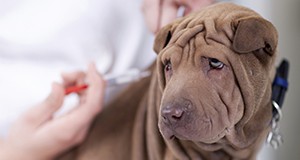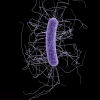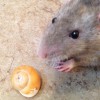Healthcare-associated infections are infections that patients can get while receiving medical treatment in a healthcare facility. One opportunistic pathogen, Clostridium difficile, has been getting more attention in recent years because of its association with antibiotic use and a high death rate among the elderly. This 7-page factsheet will provide an overview of Clostridium difficile infection (CDI) with a focus on healthcare-associated infections. Written by Soohyoun Ahn and Amarat H. Simonne and published by the UF/IFAS Department of Food Science and Human Nutrition, January 2018.
http://edis.ifas.ufl.edu/fs253
Tag: Infectious Diseases
Facts about Wildlife Diseases: Rabies
 Rabies is a virus carried by mammals. It kills infected humans and animals if they are not treated shortly after exposure. Rabies can be prevented, but it cannot be cured once symptoms become evident. This 6-page fact sheet explains how rabies spreads, which animals can get it, how common it is, symptoms, what you can do to limit its spread and what to do in case of a possible rabies exposure. Written by Samantha M. Wisely and Holly K. Ober, and published by the UF Department of Wildlife Ecology and Conservation, June 2015.
Rabies is a virus carried by mammals. It kills infected humans and animals if they are not treated shortly after exposure. Rabies can be prevented, but it cannot be cured once symptoms become evident. This 6-page fact sheet explains how rabies spreads, which animals can get it, how common it is, symptoms, what you can do to limit its spread and what to do in case of a possible rabies exposure. Written by Samantha M. Wisely and Holly K. Ober, and published by the UF Department of Wildlife Ecology and Conservation, June 2015.
http://edis.ifas.ufl.edu/uw282
Clostridium difficile: an Important Opportunistic Pathogen in Healthcare-Associated Infections
 Opportunistic pathogens are significant health threats to vulnerable people with weakened immune systems, such as people with HIV/AIDS or those on immune-suppressing therapies. One opportunistic pathogen, Clostridium difficile, has been getting more attention in recent years because of its association with antibiotic use and high death rate in the elderly. This factsheet will provide an overview of Clostridium difficile infection (CDI) with a focus on healthcare-associated infections. This 5-page fact sheet was written by Soohyoun Ahn and Amarat H. Simonne, and published by the UF Department of Food Science and Human Nutrition, September 2014.
Opportunistic pathogens are significant health threats to vulnerable people with weakened immune systems, such as people with HIV/AIDS or those on immune-suppressing therapies. One opportunistic pathogen, Clostridium difficile, has been getting more attention in recent years because of its association with antibiotic use and high death rate in the elderly. This factsheet will provide an overview of Clostridium difficile infection (CDI) with a focus on healthcare-associated infections. This 5-page fact sheet was written by Soohyoun Ahn and Amarat H. Simonne, and published by the UF Department of Food Science and Human Nutrition, September 2014.
http://edis.ifas.ufl.edu/fs253
Rat lungworm Angiostrongylus cantonensis (Chen, 1935) (Nematoda: Strongylida: Metastrongylida)
 Like many pest and disease problems, rat lungworm has been slowly spreading around the world. First described by Chen from rats in China, the medical significance of this parasite was overlooked until 1944 when it was found infecting humans in Taiwan. Even then, because the report was published in Japanese, its importance remained largely unknown. In 1955, Mackerras and Sandars found this nematode among rats in Brisbane, Australia, and described its life cycle, including the importance of its molluscan intermediate hosts. This 4-page fact sheet was written by John Capinera and Heather S. Walden, and published by the UF Department of Entomology and Nematology, September 2013.
Like many pest and disease problems, rat lungworm has been slowly spreading around the world. First described by Chen from rats in China, the medical significance of this parasite was overlooked until 1944 when it was found infecting humans in Taiwan. Even then, because the report was published in Japanese, its importance remained largely unknown. In 1955, Mackerras and Sandars found this nematode among rats in Brisbane, Australia, and described its life cycle, including the importance of its molluscan intermediate hosts. This 4-page fact sheet was written by John Capinera and Heather S. Walden, and published by the UF Department of Entomology and Nematology, September 2013.
http://edis.ifas.ufl.edu/in1007
